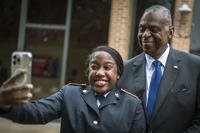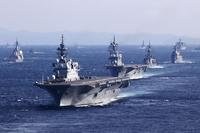Northrop Grumman and the Navy have high hopes for the MQ-8 Fire Scout unmanned helicopter, but first they have to get cleared to fly again.
The Navy's existing fleet of Fire Scouts was prohibited from flying -- though not, its program manager said Tuesday, technically "grounded" -- after two crashes in action a few weeks ago. The Fire Scout that crashed on March 30 near the frigate USS Simpson didn't even technically crash, insisted Navy Capt. Patrick Smith; its crew couldn't coax it in to land, and after 17 tries, sailors ordered the robo-helo to ditch in the ocean and then fished it out themselves.
"It was a conscious decision to terminate flight," Smith said.
Smith said officials are confident that problem was caused by the gear that helps the Fire Scout as it comes into land, and not connected to another crash April 6, in Afghanistan. That one remains unsolved, he said, and until the investigation yields more information, the Navy won't know exactly what happened. In the meantime, the rest of the service's Fire Scouts are not flying unless commanders see a pressing operational need to do so.
That means the Simpson, which sailed with two Fire Scouts and no human-flown MH-60 Seahawks, has no air asset for the time being. The troops in Afghanistan who've been using the video captured by the Fire Scouts can't. And depending on how long the ... ground-stop, shall we say? ... lasts, it could also inconvenience another frigate, the USS Klakring, which is gearing up to deploy this summer with four Fire Scouts and no Seahawks.
In true Navy fashion, however, Smith and industry officials remain bullish about the future of the program. Today's version of the helo, the MQ-8B, is a centerpiece of the littoral combat ships' projected mission capabilities, and planners are agog over the possibilities. (Imagine a "hunter-killer" group of Fire Scouts equipped with sonar and torpedoes that could work together hunting submarines at a safe distance from a Navy warship -- et cetera.)
And Northrop is working on a new version of the Fire Scout, though it won't look anything like today's: In the MQ-8C, Northrop will transplant the brains of today's robo-helo into a new body, the Bell 407, and remove the human trappings in its cockpit. The company needs a bigger airframe to answer the latest requirements from U.S. Africa and Central Commands: for an unmanned bird that can fly 150 nautical miles from its parent ship and loiter about eight hours, Smith said. Northrop expects to build 28 of them.
That doesn't mean the Navy and Northrop have forgotten about the B-model, however. Smith said engineers are working on equipping today's Fire Scouts with small missiles -- BAE Systems' Advanced Precision-Kill Weapons System -- as well as a new radar for "wide-area search capability."








